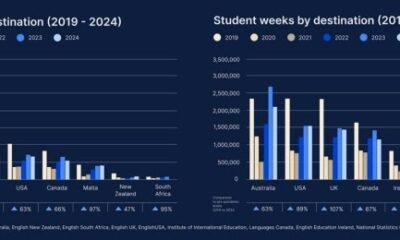Education
Record number of Chinese undergrads applying to UK unis

Some 33,870 Chinese students applied to UK universities and colleges via UCAS by the June cutoff this year, up from 30,860 in 2024. It marks a record number of Chinese students applying to institutions in this way.
Other notable year-on-year increases can be seen in applicants from Ireland (up 15%), Nigeria (up 23%) and the US (up 14%) which have contributed to a slight overall increase in international applicants using UCAS, the data shows.
The total number of undergraduate international applicants using the UCAS system was at 138,460 by June 2025 – up 2.2% on June 2024 numbers.
But while the number of offers made to international graduates outside of the EU continues to grow – up 10.7% year on year – this cohort of students was the least likely to be made an offer, at 63.5%.
“The June data is most useful for telling us what has happened since January,” explained Mark Corver, founder and former MD of dataHE, who suggested that one area of disappointment for UK universities will be continuing weak demand from the EU once “special case” Ireland is taken out, with young applicants from the EU fractionally lower than last June.
“Universities value EU students for diversity in their international intakes and the lower geopolitical and distance related risks. They would have liked to have seen growth here but will be pleased that the fall is the smallest yet since EU students fell into the international fee category,” said Corver.
However, the data released today does not offer the full picture, with UCAS pointing out that its data only shows a partial view of undergraduate international admissions in the UK.
With 154,000 Chinese students studying in the UK in 2022/23, the British Universities’ China Association (BUCA) said the 10% rise in Chinese undergraduate applications via UCAS reflects “sustained interest in UK higher education”. Several key drivers underpin this demand, including domestic academic pressures and tighter immigration rules in other study destinations such as the US, Canada and Australia.
“More families are opting out of the highly competitive public high school system in favour of international schools, which provide a less stressful environment. These students are ineligible to sit the Gaokao and must pursue undergraduate education abroad,” the association’s executive committee explained to The PIE.
“The China market continues to play a pivotal role in international recruitment strategies for UK universities. However, changing student preferences, increasing global competition, and evolving regulatory frameworks are reshaping the landscape. A data-led, agile approach is essential to sustaining engagement and growth.”
And BUCA noted that while rising UCAS applications are encouraging, they do not guarantee conversion.
“Chinese students frequently apply to multiple countries. Rising tuition fees and living costs in the UK, coupled with increasing financial caution among families, also influence final decisions. Therefore, institutions must balance optimism with realistic financial planning.”
Chinese students frequently apply to multiple countries… institutions must balance optimism with realistic financial planning
British Universities’ China Association
With numbers from the US also attracting attention, Corver weighed in on the notion that the new Trump administration has made staying at home less attractive for US students.
“The number of young applicants is up 15%, a high but not exceptional year-on-year increase. But the growth in applicants over the past six months has been very normal, a bit below average in fact, which is perhaps not what you would expect to see if there was strong behavioural change,” he explained.
According to Corver, overall the June data is “a reminder that international demand (and recruitment) to full-time undergraduate through UCAS has been both growing, and doing so in a low variance way”.
“This likely reflects that the three year commitment and substantial fees means that the quality and suitability of the course are the primary factors. Universities know this, and many I know are looking to increase their share of international recruitment to these programs rather than the easier, but much more volatile, PGT courses,” he said.
“The large increases in offer rates this year are one sign of this, but we will have to wait to see if applicants follow through and take up the places as the cycle concludes.”
More than two million offers were made to people applying for UK undergraduate courses starting this September – 74,000 more than last year, a 9% increase since 2023. International students saw the biggest rise in offer rates, with 64% of their university applications being successful, up from 59% last year and 55% in 2023.
Education
Unlocking Success with Custom Learning Paths and AI

Highlights
- The age of one-size-fits-all education is making way for something more flexible, and something that may be even more effective.
- AI is making the dream of a truly custom learning path a reality, where the individuality of every learner is respected, instead of being forced to adapt.
- The role of AI in the field of education is to create opportunities for learners to grow at a comfortable pace, discover strengths, and achieve goals
Transforming Education is redefining learning beyond the one-size-fits-all model. For generations, traditional education has made use of a one-size-fits-all model, where all learners are expected to progress through their curriculum at the same pace and showcase a level of understanding that is identical and uniform. Students sat in the same classroom, read from the same textbooks, and moved through lessons at the same pace, regardless of whether the material felt too easy or impossibly hard.
While this approach works to some extent, it leaves behind students who demonstrate a different form of understanding, may it be because of pace, style, or background knowledge. In this era of fast-paced digitalization, rigidity is being challenged by a wave of AI-driven personalized learning.
AI is changing how we approach education by offering learners a custom learning path, enabling them to study in a manner that suits them best, be it in terms of abilities, interests, or goals. Adaptive technology is no longer a futuristic idea; they are actively reshaping how classrooms, corporate training, and online education platforms are implemented.
The Problem with One-Size-Fits-All Education
The traditional model of education has but one major flaw. It is often assumed that all students, no matter what their standing, progress through the same material in the same way. This does not tend to work, as classrooms are filled with students from varied backgrounds, many of whom think and process information differently.
This approach creates a uniform studying environment, but can often lead to frustration among learners. Those who have faster learning capabilities may feel held back, or maybe even bored by lessons that progress slowly. On the other hand, struggling students may be left behind altogether. Over time, this gap widens, leaving many students questioning their ability to succeed. The system’s rigidity does not just hinder a learner’s potential and academic performance; it can also affect confidence and momentum.
How AI is Changing the Game
With the help of AI, students can opt for a more unique path, one that is more personalized. Unlike traditional teaching methods that treat everyone in the same manner, AI tools can be adjusted based on a student’s progress, strengths, and struggles. If a particular learner seems to master a particular concept quickly, the system moves them on to something that may be a bit more advanced. Similarly, if another learner stumbles, it offers extra explanations, practice sessions, or alternative ways of presenting the material.

These systems also learn and adapt to the needs of a student, and are not limited to the pacing of a lesson. Someone who benefits from videos might be provided with more visual explanations, while another who best proceeds through reading will be given text-based resources. Real-time feedback is another powerful feature at play here. Instead of waiting days for a teacher to grade an assignment, AI can immediately highlight errors, explain why something is wrong, and encourage the learner to try again.
In this way, AI is not just delivering content; it is acting like a patient tutor who is available constantly and who adapts to every lesson to the individual sitting in front of the screen.
Platforms Leading the Way
This shift to a more personalized experience is not a distant dream. Many platforms are already showing what this type of learning looks like when in practice. Language-learning apps, for example, adjust lessons on the fly depending on how questions a learner gets right or wrong.
Instead of delivering the same set of lessons to every learner, Duolingo adjusts the content in real-time. If a learner makes frequent mistakes with verb conjugations, the app serves up extra practice in that area. Or if they are excelling, it introduces more complex sentences to keep the challenges alive. Over time, no two learners follow exactly the same path.
Educational websites like Khan Academy now use AI assistants to guide learners through step-by-step exercises, almost like a digital tutor. Moving far beyond its original collection of educational videos, the platform uses adaptive exercises and even an AI-powered tutor named Khanmigo, which guides students through problems one step at a time.

Even major online course providers such as Coursera and edX recommend courses or learning materials based on a person’s career goals or past achievements. For example, someone who completes an introductory course in data analysis might automatically be directed toward machine learning or visualization courses to build their skills. These systems mimic the way a career counselor might guide a student, but they do so at scale, helping millions of learners around the world to find paths that make sense for them.
Corporate training programs are also embracing the tools. Employees no longer need to sit through generic workshops. Instead, platforms can assess what skills they already have and then design a learning path that focuses on areas that need strengthening. This kind of personalization saves a lot of time and ensures that people are learning skills that are directly relevant to their jobs.
Platforms such as LinkedIn Learning or Udemy for Business are helping employees keep up with rapidly changing job requirements. Instead of offering a user a long list of courses that is bound to leave them confused, these platforms use AI to analyze each employee’s role, along with their skills and interests. The result is a well-curated learning journey that focuses on filling specific gaps or preparing for future promotions.
Even in schools, early experiments with personalized platforms are changing the everyday classroom experience. Adaptive math programs like DreamBox and literacy tools such as Newsela tailor various lessons to the needs of the individual, while still aligning with modern curriculum standards.
Why Personalized Learning Matters
When education feels personal, it automatically becomes a lot more engaging for all who are involved. Learners are far more likely to stay motivated when the material feels relevant and, more importantly, achievable. Instead of experiencing the frustration of being lost or the boredom of waiting for others to catch up, students may feel a lot more comfortable being challenged at just the right level. This balance helps keep curiosity alive and makes learning something people want to do rather than something they have to do.

Personalization also improves memory and understanding. By going back and revisiting difficult topics until they are mastered, learners will build stronger foundations. At the same time, they can progress quickly through any material that they feel comfortable with, making the entire process more efficient. For those pursuing careers, this approach ensures that their progress stays aligned with their goals, allowing for actual positive growth.
Perhaps the most important part of personalization is that it has the power to make education more equitable. It does not leave struggling students behind, instead providing them with the additional assistance they need, while more advanced learners continue to move forward. Everyone benefits, and fewer people fall through the cracks.
Challenges on the Horizon
Despite its promise, AI-driven personalization is not without its flaws and challenges. Collecting and analyzing vast amounts of student data naturally raises concerns in terms of privacy and security. Ensuring that this information is used responsibly and stored safely is a major priority. There is also the issue of bias. If the data that is used to train the system is flawed, the AI may tend to unintentionally favour certain groups over others.
Another hurdle to be taken into account is accessibility. Not all schools or communities have the required resources or the infrastructure needed to implement such technologies. There is also the human side to consider, as teachers will no longer be there to deliver content, but instead be dedicated to a mentor or facilitator-like role.

Looking forward, the role of AI in terms of education is likely to become even more transformative. As these technologies become even more widespread, the vision of a world where every learner has access to personalized education could move from possibility to reality.
Education
Behind the latest dismal NAEP scores

The National Assessment for Educational Progress, called NAEP or the Nation’s Report Card, has long been considered the gold standard for understanding how American students are doing. So bad headlines were inevitable last week when the long-delayed 2024 results for 12th graders in math and reading and for eighth graders in science were finally released.
It is tempting to blame the long tail of the pandemic for the dismal scores. But folks who keep a close eye on NAEP had some provocative analysis.
Eric Hanushek: It’s not just the pandemic
Eric Hanushek, a senior fellow at Stanford University’s Hoover Institution, points out that the 3-point declines for 12th graders between 2019 and 2024 are in line with the long-term achievement losses that he’s been seeing since 2013. In a paper this month, written before the 12th grade 2024 NAEP scores were released, he documented that the learning losses during the pandemic match those that occurred before and after the pandemic. In other words, student achievement is declining for reasons other than Covid school disruptions.
Hanushek calculated that restoring student achievement to 2013 levels would raise the lifetime earnings of today’s average student by an estimated 8 percent and would produce dramatic and sustained gains for the national economy.
Related: Our free weekly newsletter alerts you to what research says about schools and classrooms.
Dan McGrath: It could have been worse
Dan McGrath, the retired former associate commissioner for assessments at the National Center for Education Statistics, used to oversee NAEP until he lost his job in March during mass layoffs at the Education Department.
Now he’s sharing his personal analysis of NAEP score data in a newsletter. McGrath points out that the slide in eighth grade science and 12th grade math and reading is “not as bad” as he had expected.
He based that prediction on deteriorating scores for students this age before the pandemic, and pandemic-era losses for fourth and eighth graders. He said he would have expected drops twice as large: 8 points instead of just 3 to 4 points.
Any decline is bad. McGrath said that students who were in eighth grade in the spring of 2024 (and are now starting 10th grade in high school) are less prepared for difficult high school science courses, and students who graduated high school in 2024 went to college or into the workforce “underskilled” compared to students before them.
But given that McGrath had predicted far worse results, these NAEP scores are “kinda sorta good news,” he said. Why did 12th graders weather the pandemic better than eighth graders did, and why did science skills hold up better than math and reading for eighth graders? “I don’t know,” wrote McGrath.
Related: NAEP, the Nation’s Report Card, was supposed to be safe. It’s not
Andrew Ho: Missing data
Harvard University education professor Andrew Ho lamented on LinkedIn that the recent NAEP release isn’t that useful. For starters, the long five-year gap (from 2019 to 2024) between the tests of 12th graders means that we cannot tell if the 2024 results represent a pandemic decline or recovery from an earlier nadir.
That matters. Education policymakers have no way of knowing if high schools are back on an upward track (and should continue doing what they are doing) or not (and change course).
Also, there’s no state data for 12th graders to help us see bright spots to emulate.
That frequency and breadth already takes place for fourth and eighth graders. Leslie Muldoon, executive director of the board that oversees the NAEP test, commented that more frequent and state-by-state testing of high schoolers is a future priority.
Related: A smaller NAEP
Reversing course and rehiring at the Education Department
Adding tests might seem like a pipe dream in the wake of budget and staffing cuts at the Education Department. All the staffers dedicated to NAEP were fired in March as part of a mass downsizing that Education Secretary Linda McMahon said was a first step toward eliminating the department.
However, the Education Department is now starting to rehire staff to help administer the NAEP exam — a sign that the administration intends to preserve at least one function of the agency that President Donald Trump wants to abolish.
So far two new jobs have been posted — one to oversee the development of test questions and the other to supervise the administration of the tests. These are the first two of at least eight positions that the Education Department plans to fill this fall, according to an education department official with the National Center for Education Statistics who briefed reporters this month.
Contact staff writer Jill Barshay at 212-678-3595, jillbarshay.35 on Signal, or barshay@hechingerreport.org.
This story about NAEP scores was produced by The Hechinger Report, a nonprofit, independent news organization focused on inequality and innovation in education. Sign up for Proof Points and other Hechinger newsletters.
Education
Turning superintendent transitions into strength–not division

Key points:
When a long-serving superintendent departs, districts inherit more than a vacancy. They inherit emotion, legacy, and the uncertainty that comes with change. With superintendent tenure shrinking nationwide, the real question isn’t if transitions will happen; it’s whether districts can navigate them without losing momentum for students.
I stepped into the superintendency at Mississinewa Community Schools following the retirement of a respected leader. We avoided the common pitfalls, mixed messages, rumor spirals, and initiative drift by treating the transition as a community moment rather than a personnel change.
Here are practical steps any district can adapt, regardless of size or setting.
1. Model professionalism, especially when it’s hard
Leadership changes often mean disappointment for people who’ve given years to the district. Ask outgoing leaders to help “set the table” for what’s next: Attend public meetings, co-host early listening sessions, and make warm handoffs to key staff and partners.
Why it works: Visible unity lowers anxiety and keeps adults focused on students, not politics.
Try this: Create a two-page “transition script” with shared talking points, key dates, and who says what, when.
2. Go first with transparency
Transitions are prime time for speculation. Beat it with a simple, repeated message: what’s changing, what’s not, and when stakeholders can weigh in.
Why it works: Predictability builds trust; small, frequent updates outperform lengthy, sporadic memos.
Try this: A 60-day communications cadence; weekly staff note, biweekly family/community update, and a brief public dashboard tracking immediate priorities (e.g., safety, staffing, instruction, operations).
3. Build trust through presence, not pronouncements
Spend full days in each school early on–not for photo ops, but for structured listening. Invite a veteran leader with deep relationships to walk alongside the new leader.
Why it works: Trust is built in classrooms and hallways. Side-by-side introductions transfer social capital and signal continuity.
Try this: Use a three-question listening protocol: What’s working students-first? What’s getting in the way? What’s one quick win we can try this month? Close the loop publicly on what you heard and acted on.
4. Protect instructional continuity
Transitions can unintentionally pause or reset key initiatives. Identify the 3-5 “do-not-drop” items (e.g., early literacy practices, MTSS, PLC rhythms) and assign explicit owners and check-ins.
Why it works: Students shouldn’t feel the turbulence of adult change.
Try this: A one-page “continuity plan” listing each initiative, the non-negotiables, owners, and 30/60/90-day milestones.
5. Anchor every decision in integrity
People watch how leaders behave under stress. Humility from those exiting, patience from those staying, and clarity from those arriving are all forms of integrity that audiences read quickly.
Why it works: Integrity reduces drama and accelerates collaboration.
Try this: Adopt a simple decision rubric you can publish: Is it student-centered? Is it equitable? Is it feasible this term? Share how recent decisions aligned with the rubric.
A quick-start checklist (steal this)
- Day 0–15: Announce the continuity plan; align the cabinet on 3-5 non-negotiables; publish listening tour dates.
- Day 30: Report “you said/we did” updates; celebrate quick wins; schedule joint appearances with outgoing leaders where appropriate.
- Day 60: Refresh the dashboard; confirm owners/timelines for longer-horizon work; address one stubborn, high-visibility pain point.
- Day 90: Publicly close the transition phase; restate the district’s instructional priorities and how they will be measured.
Watchouts
- Mixed messages: If leaders aren’t saying the same thing, you’re fueling rumors. Script and rehearse.
- New-initiative temptation: Resist “rebranding” just to mark the moment. Improve execution first; rename later.
- Invisible wins: Listening without visible action erodes trust. Close loops quickly–even on small items.
Bottom line
Leadership transitions aren’t just about titles; they’re about people and the students we serve. With professionalism, transparency, presence, and integrity, districts can turn a vulnerable moment into a unifying one and keep learning at the center where it belongs.
-

 Business2 weeks ago
Business2 weeks agoThe Guardian view on Trump and the Fed: independence is no substitute for accountability | Editorial
-
Tools & Platforms1 month ago
Building Trust in Military AI Starts with Opening the Black Box – War on the Rocks
-

 Ethics & Policy2 months ago
Ethics & Policy2 months agoSDAIA Supports Saudi Arabia’s Leadership in Shaping Global AI Ethics, Policy, and Research – وكالة الأنباء السعودية
-

 Events & Conferences4 months ago
Events & Conferences4 months agoJourney to 1000 models: Scaling Instagram’s recommendation system
-

 Jobs & Careers3 months ago
Jobs & Careers3 months agoMumbai-based Perplexity Alternative Has 60k+ Users Without Funding
-

 Podcasts & Talks2 months ago
Podcasts & Talks2 months agoHappy 4th of July! 🎆 Made with Veo 3 in Gemini
-

 Education3 months ago
Education3 months agoVEX Robotics launches AI-powered classroom robotics system
-

 Education2 months ago
Education2 months agoMacron says UK and France have duty to tackle illegal migration ‘with humanity, solidarity and firmness’ – UK politics live | Politics
-

 Funding & Business3 months ago
Funding & Business3 months agoKayak and Expedia race to build AI travel agents that turn social posts into itineraries
-

 Podcasts & Talks2 months ago
Podcasts & Talks2 months agoOpenAI 🤝 @teamganassi





















